Best Evergreen Trees for Privacy
- December 21, 2023
- 0 comment
Privacy in our homes and gardens is a cherished and often essential aspect of modern living. As urban areas become denser and the desire for natural, green spaces grows, finding effective and aesthetically pleasing ways to shield our personal spaces from prying eyes becomes increasingly important. The solution lies not in high walls or artificial barriers, but in one of nature’s most enduring gifts: evergreen trees.
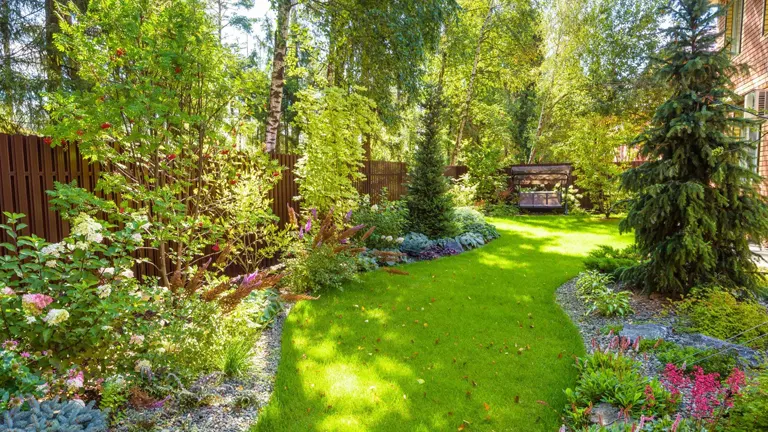
In this discussion, we delve into the world of evergreen trees, specifically focusing on the best varieties for creating privacy screens in your garden or property. From the lush, dense foliage of the Arborvitae to the towering majesty of the Spruce, each tree offers unique characteristics that make it suited for different climates, spaces, and personal preferences. Join us as we explore how these living green walls can not only enhance your privacy but also add beauty and tranquility to your environment.
List of Evergreen Trees for Privacy:
10 Evergreen Trees for Privacy Top Picks
1. Arborvitae (Thuja)
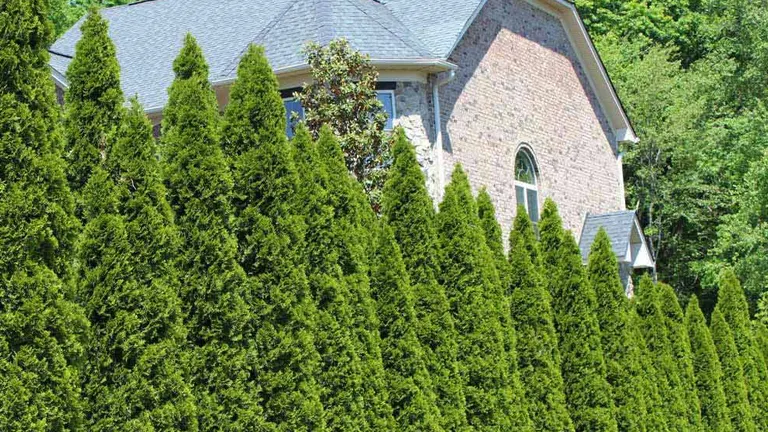
Arborvitae is a popular choice for privacy screens due to its dense foliage and upright growth habit. Varieties such as ‘Emerald Green’ and ‘Green Giant’ are particularly favored for their ability to grow between 10-15 feet wide and 30-40 feet high, depending on the specific type. These trees are low-maintenance, requiring only occasional pruning to keep their shape. They are hardy in USDA zones 2-7 and are resistant to most pests and diseases, making them a robust and reliable choice for privacy.
- Pros: Dense foliage for excellent privacy, low maintenance, and adaptable to various climates.
- Cons: Can suffer in high winds or heavy snow, susceptible to bagworms and spider mites.
- Pest/Disease Resistance: Generally resilient but watch for bagworms and treat with insecticidal soap or neem oil.
- Environmental Impact: Provides habitat for birds, supports biodiversity, and acts as a carbon sink.
2. Leyland Cypress (x Cupressocyparis leylandii)
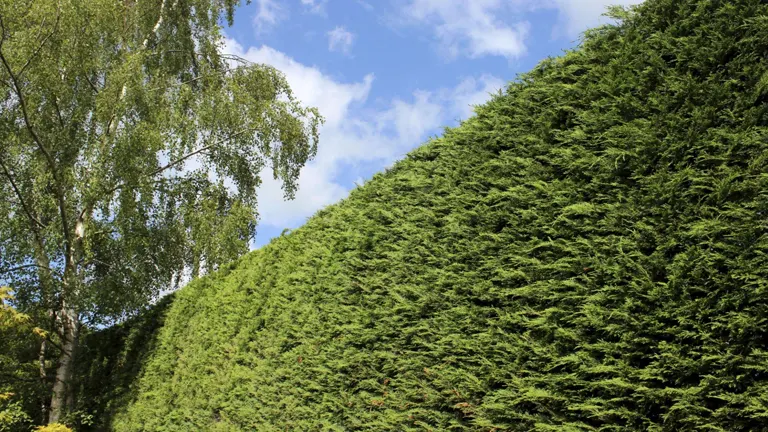
The Leyland Cypress is known for its rapid growth, potentially adding 3-4 feet per year and reaching heights of 60-70 feet. This tree is ideal for those seeking quick privacy solutions. It requires regular pruning to control its size and shape and thrives in USDA zones 6-10, preferring full sun. When planting Leyland Cypress, it’s important to allow enough room for growth, as these trees can become quite large.
- Pros: Fast growth rate, effective for quick screening.
- Cons: Can become too large if not regularly pruned, susceptible to canker diseases.
- Pest/Disease Resistance: Vulnerable to Seiridium and Botryosphaeria canker; proper spacing and air circulation are crucial for prevention.
- Environmental Impact: Offers substantial carbon sequestration but limited biodiversity support.
3. Boxwood (Buxus)

Boxwood is an excellent choice for smaller spaces or formal hedges due to its slow growth and ability to be shaped and maintained at various heights. It can reach a height of 5-20 feet and is suitable for USDA zones 4-9. Boxwoods require regular pruning to maintain their shape, making them a popular choice for formal garden designs.
- Pros: Ideal for formal designs, small spaces, easy to shape.
- Cons: Prone to boxwood blight and requires regular pruning.
- Pest/Disease Resistance: Susceptible to boxwood blight; regular monitoring and removal of affected parts is necessary.
- Environmental Impact: Provides dense foliage for small wildlife, but environmental benefits are moderate due to high maintenance needs.
4. Holly (Ilex)
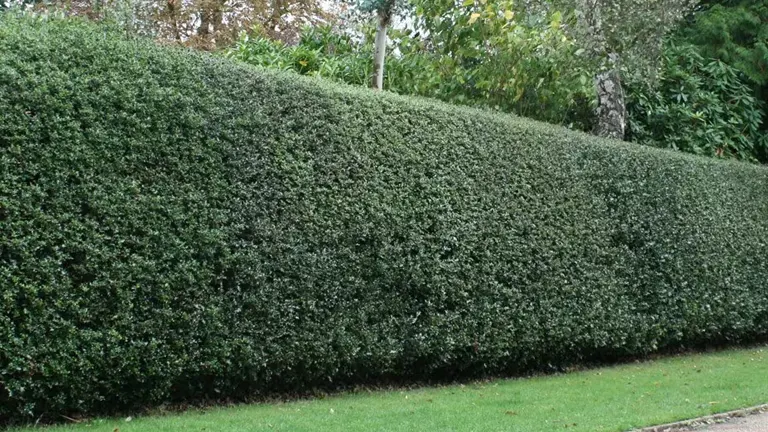
Holly trees offer privacy and aesthetic appeal with their glossy leaves and bright berries. Some varieties, like ‘Nellie R. Stevens’, are particularly popular for their dense growth. Holly trees can grow up to 50 feet tall, depending on the species, and are hardy in USDA zones 5-9. They require moderate maintenance, with occasional pruning to keep their desired size and shape.
- Pros: Aesthetic appeal with berries and glossy leaves, drought-resistant.
- Cons: Some species have sharp leaves, and berries can be toxic if ingested.
- Pest/Disease Resistance: Watch for holly leaf miner and scale insects. Use horticultural oil for control.
- Environmental Impact: Excellent for wildlife, providing food and habitat, especially in winter.
5. Spruce (Picea)
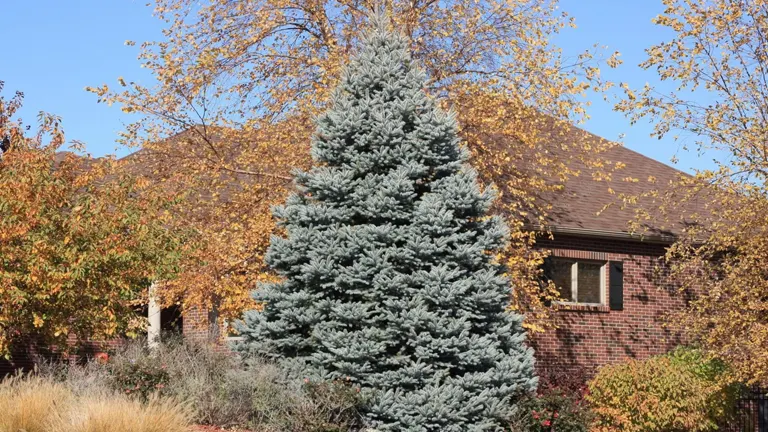
Spruce trees, such as the Colorado Blue Spruce, are hardy in many climates and provide excellent privacy due to their dense foliage. Depending on the species, they can reach heights of 50-150 feet. Spruces require minimal maintenance and are known for their classic conical shape, reminiscent of a traditional Christmas tree.
- Pros: Hardy in various climates, classic conical shape.
- Cons: Can require significant space, susceptible to spruce aphids.
- Pest/Disease Resistance: Prone to aphids and spruce beetle; maintain health to prevent infestations.
- Environmental Impact: Provides habitat for birds and small mammals, good for carbon sequestration.
6. Yew (Taxus)
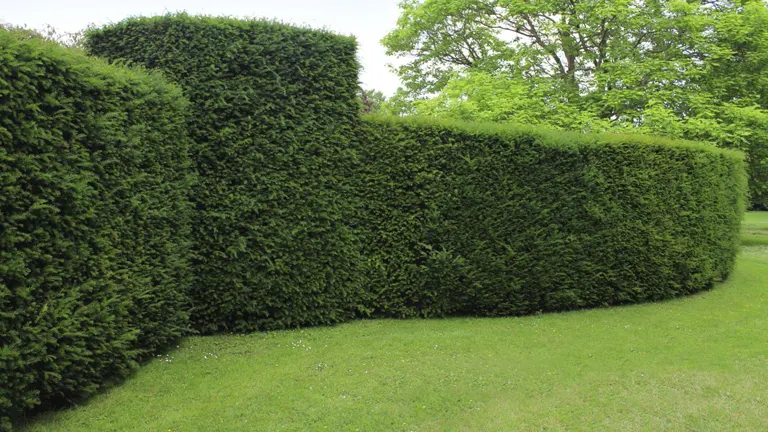
Yew trees are favored for their dense, dark green foliage that can be shaped into formal hedges. They are slow-growing, reaching heights between 10-40 feet, and are suitable for shaded areas where other conifers might not thrive. Yews are hardy in USDA zones 4-7 and require moderate maintenance. It’s important to note that their foliage and berries are toxic if ingested.
- Pros: Tolerates shade, excellent for sculpted hedges.
- Cons: Toxic if ingested, slow-growing.
- Pest/Disease Resistance: Can suffer from root rot in overly wet conditions. Ensure good drainage.
- Environmental Impact: Offers dense cover for wildlife; berries are a food source for birds.
7. Fir (Abies)
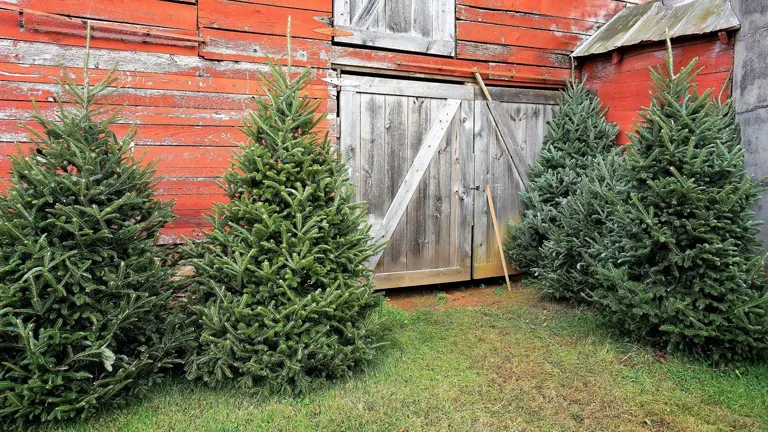
Fir trees, like the Nordmann Fir, offer a dense canopy ideal for privacy screens. Their growth rate and ultimate height vary by species, with some reaching over 50 feet. They have low to moderate maintenance needs and are known for their distinct, pleasant fragrance. Firs are generally suitable for USDA zones 4-7.
- Pros: Pleasant fragrance, dense foliage for privacy.
- Cons: Large varieties may require significant space, can be susceptible to balsam woolly adelgid.
- Pest/Disease Resistance: Vulnerable to adelgids and fir engraver beetles in stressed conditions. Maintain tree health as a preventive measure.
- Environmental Impact: Excellent for wildlife habitats and carbon sequestration.
8. Bamboo
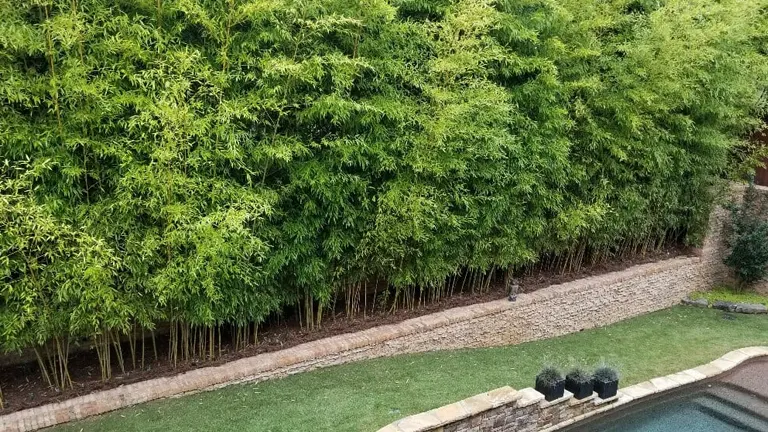
Although not a traditional tree, clumping Bamboo is a fast-growing option for privacy screens. Some species can reach up to 35 feet and are ideal for creating an Asian-inspired or modern minimalist garden design. Bamboo requires moderate maintenance, particularly containment measures to prevent spreading. The hardiness of bamboo varies with species, with some being suitable up to USDA zone 4.
- Pros: Fast growth, modern aesthetic, good for quick screening.
- Cons: Can be invasive if not properly contained, requires regular maintenance.
- Pest/Disease Resistance: Generally pest-resistant, but watch for bamboo mites.
- Environmental Impact: Fast growth means high carbon uptake, but invasiveness can impact local biodiversity negatively.
9. Norway Spruce (Picea abies)
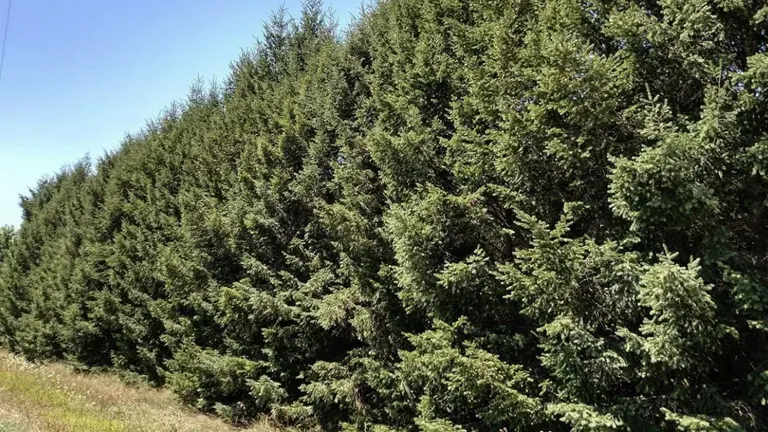
The Norway Spruce is a fast-growing tree that can reach heights of 50-60 feet. It is low-maintenance and hardy in zones 2-7, adaptable to various soil types. This tree is often used in large landscapes and as a windbreak due to its size and dense branching.
- Pros: Fast-growing, ideal for large spaces and windbreaks.
- Cons: May be too large for smaller gardens, can suffer from spruce gall aphids.
- Pest/Disease Resistance: Prone to gall aphids and spruce budworm; proper care and monitoring are important.
- Environmental Impact: Provides excellent habitats for wildlife, significant carbon sink.
10. Pine (Pinus)
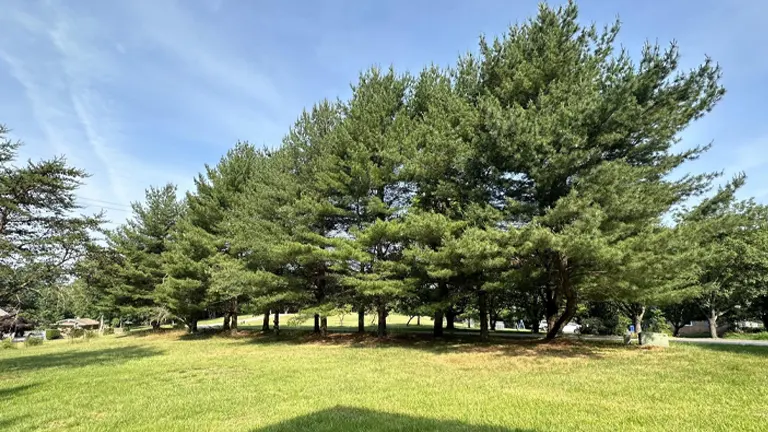
Pine trees are known for their distinct cones and needles, adding a unique textural element to landscapes. Their growth habits and ultimate heights vary greatly by species, with some growing over 100 feet tall. Pines are adaptable to a wide range of climates, suitable for USDA zones 2-9, and require low maintenance. Occasional pruning may be needed to maintain their shape.
- Pros: Diverse varieties, iconic pine cones, and needles.
- Cons: Some species susceptible to pine beetles and rusts.
- Pest/Disease Resistance: Vulnerable to pine beetles and white pine blister rust. Regular health checks and proper spacing are essential.
- Environmental Impact: Supports a diverse range of wildlife, good for carbon sequestration, and improves soil health over time.
General Maintenance Guide for Privacy Evergreen Trees
Watering
When it comes to watering your privacy evergreen trees, the approach varies slightly between newly planted and established trees. For newly planted trees, it’s crucial to water them regularly to help establish their roots. This typically involves watering deeply once or twice a week, but the exact frequency depends on weather conditions and soil type. Once the trees are established, which usually takes about 1-2 years, they tend to be more drought-tolerant. However, during extended periods of dry weather, it’s beneficial to give them occasional deep watering to ensure their health and vitality.
Fertilizing
Fertilizing your evergreen trees is most effective when done in early spring. A balanced, slow-release fertilizer is ideal for promoting healthy growth. If you have acid-loving species like Holly, consider using a specialized fertilizer. It’s important to avoid over-fertilizing, as this can lead to rapid, weak growth, making the trees more vulnerable to pests and diseases. A gentle approach with consistent yearly feeding usually yields the best results.
Pruning
Pruning is a critical aspect of maintaining the health and appearance of your privacy trees. The best time to prune is typically in late winter or early spring, just before new growth starts. Regular pruning is essential for shaping and controlling the size of your trees, especially for hedge varieties like Boxwood and Yew. Additionally, always be vigilant about removing any dead or damaged branches, as this helps prevent the spread of disease and encourages healthier growth overall.
Pest and Disease Management
To ensure your privacy trees remain healthy and free from pests and diseases, regular inspection is key. If you notice any signs of infestation or disease, it’s important to address these issues early with the appropriate treatment, such as using insecticidal soaps for pests or fungicides for diseases. Preventive measures are also crucial. Ensuring good air circulation, proper spacing, and avoiding wetting the foliage during watering can significantly reduce the risk of common tree problems.
Winter Care
Preparing your evergreen trees for winter involves a few key steps. In the fall, applying mulch around the base of the trees can protect their roots from harsh winter temperatures. It’s also important to protect the trees from heavy snowfall; gently brush off any heavy snow accumulation on the branches to prevent damage. If your trees are near roads or driveways, be mindful of salt spray during the winter, as this can be harmful to them. Implementing these winter care practices will help ensure your trees survive and thrive through the colder months.
By following these guidelines, you can maintain the health and beauty of your evergreen trees, ensuring they continue to provide privacy and aesthetic appeal in your garden for years to come.
FAQs
- How quickly can I expect my privacy trees to grow?
Growth rates vary by species. Leyland Cypress and Bamboo are among the fastest-growing, while Boxwood and Yew grow more slowly. Check the specific growth rates for each tree to set realistic expectations. - How far apart should I plant privacy trees?
Spacing depends on the species and your desired density. For fast-growing trees like Leyland Cypress, 5-6 feet apart is typical. For slower-growing species like Arborvitae, 3-4 feet might suffice. Always consider the mature size of the tree. - Are there any privacy trees that are particularly low maintenance?
Arborvitae and Spruce generally require less maintenance compared to others. They need minimal pruning and are quite resilient once established. - Can privacy trees be planted in pots or containers?
Smaller species like Boxwood can thrive in pots, but larger trees like Norway Spruce are not suitable for container planting due to their size and root system. - How do I protect my privacy trees from pests and diseases?
Regular monitoring, proper spacing, and good air circulation are key. Use specific treatments like insecticidal soap for pests or fungicides for diseases as needed. - Are there privacy trees suitable for small yards?
Yes, Boxwood, Holly, and certain Arborvitae varieties can be suitable for smaller spaces due to their manageable size and growth rate. - How do I choose the right privacy tree for my climate?
Consider your USDA hardiness zone and choose trees that are known to thrive in your area. Local nurseries can be a great resource for this information.
For more information click here

David Murray
Forestry AuthorI'm David Murry, a forestry equipment specialist with a focus on chainsaw operation. With over 13 years of experience, I've honed my skills in operating and maintaining a wide range of machinery, from chainsaws to log splitters. My passion for the outdoors and commitment to sustainable forestry drive my work, which emphasizes safety, efficiency, and staying updated with industry advancements. Additionally, I'm dedicated to sharing my expertise and promoting environmental awareness within the forestry community.













Leave your comment